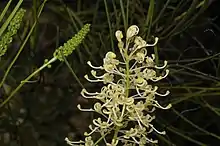Grevillea obliquistigma
Grevillea obliquistigma is a species of flowering plant in the family Proteaceae and is endemic to the south-west of Western Australia. It is a spreading shrub with linear leaves, and conical to cylindrical clusters of creamy-white to yellowish cream-coloured flowers, sometimes tinged with pink.
| Grevillea obliquistigma | |
|---|---|
 | |
| In the Australian National Botanic Gardens | |
| Scientific classification | |
| Kingdom: | Plantae |
| Clade: | Tracheophytes |
| Clade: | Angiosperms |
| Clade: | Eudicots |
| Order: | Proteales |
| Family: | Proteaceae |
| Genus: | Grevillea |
| Species: | G. obliquistigma |
| Binomial name | |
| Grevillea obliquistigma | |

Description
Grevillea obliquistigma is a shrub or small tree that typically grows to a height of 0.3–6 m (1 ft 0 in – 19 ft 8 in). Its leaves are usually linear, 40–220 mm (1.6–8.7 in) long and 0.8–2.0 mm (0.031–0.079 in) wide, sometimes divided with two or three linear lobes 0.7–1.2 mm (0.028–0.047 in) wide. The edges of the leaves or lobes are rolled under, enclosing most of the lower surface. The flowers are arranged in leaf axils and on the ends of branches, in simple or branched clusters, each branch conical or cylindrical and 50–100 mm (2.0–3.9 in) long. The flowers are creamy-white to yellowish cream-coloured, sometimes tinged with pink, the pistil 5–8 mm (0.20–0.31 in) long. Flowering time varies with subspecies, and the fruit is an oblong to oval follicle 7–15 mm (0.28–0.59 in) long.[2][3]
Taxonomy
Grevillea obliquistigma was first formally described in 1943 by Charles Gardner in the Journal of the Royal Society of Western Australia from specimens he collected near Pindar.[4][5] The specific epithet (obliquistigma) means "slanting stigma".[6]
In 1994, Peter Olde and Neil Marriott described three subspecies of G. obliquistigma in The Grevillea Book, and the names are accepted by the Australian Plant Census:
- Grevillea obliquistigma subsp. cullenii Olde & Marriott[7] is a shrub about 50 cm (20 in) high with silky-hairy branchlets, leaves about 0.8 mm (0.031 in) wide, flower clusters about 5–6 cm (2.0–2.4 in) long in September and October, with floral bracts about 1.5 mm (0.059 in) long and 0.8 mm (0.031 in) wide.[8][9]
- Grevillea obliquistigma subsp. funicularis Olde & Marriott[10] is a dense, spreading shrub about 0.5–2 cm (0.20–0.79 in) high with glabrous or silky-hairy branchlets, leaves and lobes 1–2 mm (0.039–0.079 in) wide, flower clusters 4.5–10 cm (1.8–3.9 in) long from September to December, with floral bracts 5.0–6.5 mm (0.20–0.26 in) long and 1.8–2.4 mm (0.071–0.094 in) wide.[11][12]
- Grevillea obliquistigma C.A.Gardner subsp. obliquistigma[13] is a dense, spreading shrub or spindly tree 2–6 m (6 ft 7 in – 19 ft 8 in) high with glabrous or silky-hairy branchlets, leaves and lobes 0.7–1 mm (0.028–0.039 in) wide, flower clusters 5–10 cm (2.0–3.9 in) long from July to December, with floral bracts 2.0–3.5 mm (0.079–0.138 in) long and 0.6–1.2 mm (0.024–0.047 in) wide.[14][15]
Distribution and habitat
Subspecies cullenii grows in mallee near Laverton and Cosmo Newberry in the Avon Wheatbelt and Great Victoria Desert bioregions, subspecies funicularis in open shrubland between Morawa, Mingenew and Ballidu in the Avon Wheatbelt, Geraldton Sandplains and Yalgoo bioregions, and subsp. obliquistigma is widespread from the lower Murchison River to Mount Magnet and Bullfinch in the Avon Wheatbelt, Coolgardie, Geraldton Sandplains, Murchison and Yalgoo bioregions where it is found in open shrubland.[8][9][11][12][14][15]
Conservation status
Subspecies funicularis and obliquistigma of G. obliquistigma are listed as "not threatened" but subsp. cullenii is listed as "Priority Three" by the Government of Western Australia Department of Biodiversity, Conservation and Attractions,[9][12][15] meaning that it is poorly known and known from only a few locations but is not under imminent threat.[16]
See also
References
- "Grevillea obliquistigma". Australian Plant Census. Retrieved 29 July 2022.
- "Grevillea obliquistigma". Australian Biological Resources Study, Department of Agriculture, Water and the Environment: Canberra. Retrieved 29 July 2022.
- "Grevillea obliquistigma". FloraBase. Western Australian Government Department of Biodiversity, Conservation and Attractions.
- "Grevillea obliquistigma". APNI. Retrieved 29 July 2022.
- Gardner, Charles A. (1943). "Contributiones Florae Australiae Occidentalis, XI". Journal of the Royal Society of Western Australia. 27: 169. Retrieved 29 July 2022.
- Sharr, Francis Aubi; George, Alex (2019). Western Australian Plant Names and Their Meanings (3rd ed.). Kardinya, WA: Four Gables Press. p. 263. ISBN 9780958034180.
- "Grevillea obliquistigma subsp. cullenii". Australian Plant Census. Retrieved 21 July 2022.
- "Grevillea obliquistigma subsp. cullenii". Australian Biological Resources Study, Department of Agriculture, Water and the Environment: Canberra. Retrieved 30 July 2022.
- "Grevillea obliquistigma subsp. cullenii". FloraBase. Western Australian Government Department of Biodiversity, Conservation and Attractions.
- "Grevillea obliquistigma subsp. funicularis". Australian Plant Census. Retrieved 30 July 2022.
- "Grevillea obliquistigma subsp. funicularis". Australian Biological Resources Study, Department of Agriculture, Water and the Environment: Canberra. Retrieved 30 July 2022.
- "Grevillea obliquistigma subsp. funicularis". FloraBase. Western Australian Government Department of Biodiversity, Conservation and Attractions.
- "Grevillea obliquistigma subsp. obliquistigma". Australian Plant Census. Retrieved 20 July 2022.
- "Grevillea obliquistigma subsp. obliquistigma". Australian Biological Resources Study, Department of Agriculture, Water and the Environment: Canberra. Retrieved 20 July 2022.
- "Grevillea obliquistigma subsp. obliquistigma". FloraBase. Western Australian Government Department of Biodiversity, Conservation and Attractions.
- "Conservation codes for Western Australian Flora and Fauna" (PDF). Government of Western Australia Department of Parks and Wildlife. Retrieved 30 July 2022.